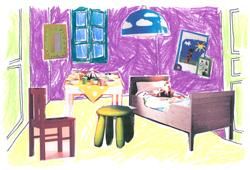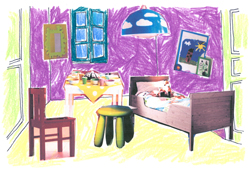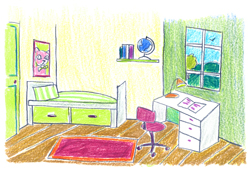Context and analysis of the work
Context
Following the revolution or 1789 that led to unprecedented upheaval in French society, the 19th century created changes that touched all areas of life, even those of the world of art.
The Impressionists had already rebelled against the established system, and Vincent Van Gogh had mixed with them thanks to his brother Theo, who was an art dealer. Not wishing to remain in the capital, Vincent Van Gogh preferred the allure of the south of France and moved to Arles.
He asked Paul Gauguin to join him to share his passion and paint together, but the idea fell through and Gauguin chose to leave for Brittany.
Following attacks of madness which led him to cut off his left ear, Van Gogh was hospitalised in the south, but his brother Theo had him taken back to the Paris region, to Auvers-sur-Oise for consultation with Doctor Gachet.
In the last two months of his life, he began a frenzy of painting that saw him produce several works a day. These particularly dark and tortured works of art heralded the artist's upcoming fate.
He committed suicide in 1890 without becoming famous, but was recognised for his talent, particularly by Gauguin.
Analysis of the work
1. In terms of form
As the name indicates, "Bedroom in Arles" depicts the artist's bedroom. It is an oil painting on canvas from 1888 in 72 x 90 cm format that is currently exhibited at the Van Gogh Museum in Amsterdam.
After the original was subject to damage, Van Gogh painted a second, slightly different version that is on display at the Art Institute of Chicago. Van Gogh also produced a final, smaller copy (57 x 74 cm) that he gave to his sister. It is exhibited at the Musée d'Orsay in Paris.
2. In terms of technique
Van Gogh used sharp brush strokes leaving thick and granular layers on the canvas, creating a material effect that is easy to recognise.
He used vanishing lines to produce an offset perspective and used straight lines to mark out different objects. His use of colour also serves to alleviate the instability of perspective.
Like his Impressionist counterparts, Van Gogh preferred light, spread out colours over large areas. Nevertheless, he also created a very personal style with a choice of colours that paved the way for two movements that followed him: Fauvism and expressionism.
3. In terms of meaning
Bedroom in Arles is not just a simple reproduction of one of the rooms in the artist's house. It was above all a way for him to express a feeling, an emotion, an occurrence here, and as he wrote to his brother Theo, "absolute rest" as a result of the bed that occupies the majority of the space as well as the choice of colours used. The colours chosen (lilac and very pale lime green) pay homage to Japan, prints of which Van Gogh studied with admiration.
The other objects present in the work, such as tables or chairs are often paired, as if Van Gogh wanted to suggest that peace, balance and order reign within his bedroom.
4. In terms of use
Through this work, Van Gogh wanted to give the appearance of the atmosphere of his room, and invites us to access this personal space.
He finished this painting while Gauguin was about to visit him to assist in founding a circle of artists.



